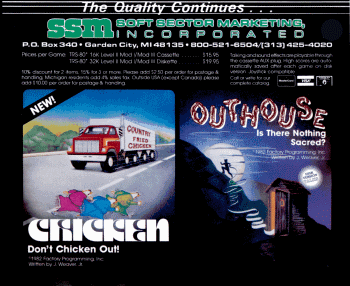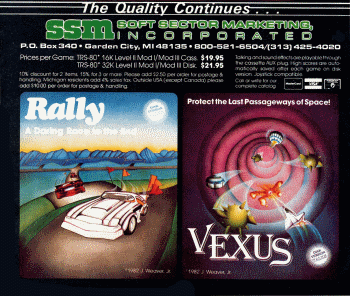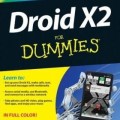An Interview With J. Weaver Jr.
J. Weaver Jr. is the author of the TRS-80 games Outhouse, Chicken, Rally, Vexus, Planetbuster, Yield, and Pulsar. In this interview, conducted in October 2008, I had the opportunity to ask him some questions about his games and his memories of the TRS-80.
Q: How did you get started with computers and the TRS-80?
A: I was an electronics geek in high school, so at an early age I started spending a fair amount of time at the local Radio Shack(s), buying parts and equipment and generally wasting time talking to fellow electronics geeks. I also wound up taking a couple of computer classes at the local community college as part of a major in business, and was intrigued by and interested in programming in general (starting with FORTRAN). At the University of Toledo, I took a BASIC programming class, and wrote my first games (which Terminal Zero kept erasing as “not class material” but which I kept reloading from paper tape).
Fast forward to 1977. I’d recently purchased a “Fairchild Channel F,” a tremendous cartridge-based video game system, but one for which (sadly) few games were released. When the Model I showed up at RS #4751 one day, my first thought (literally) was: “I could get this and write my own games and I wouldn’t have to wait for [censored] Fairchild any more.”
The scrimping and saving began that night, as did the programming — I brought home the Radio Shack BASIC programming manuals, and started “writing” code at home in the evenings on my manual typewriter, counting the characters to fit within the 3000-odd bytes free (yes, I used to know the exact number) on #4751’s 4K Level I machine. The next time I was at the store, I’d key in my “creations,” do a little debugging, and then save the results to cassette. By the time (1978) I’d saved up the $1000 (!) for my own 16K Level II system, I had several tapes full of rudimentary games, including versions of the Blackjack and Backgammon that Radio Shack gave away with the machine that didn’t crash if you hit the wrong key. I’d also actually sold a few Model I systems, simply by sitting there and typing and attracting attention; that and some other programming work got me my first disk drive for the Model I as a “thank you” gift from the store’s manager.
Q: What was Factory Programming?
A: A corporate fiction, to better isolate business expenses and make dealing with other businesses (and the IRS) easier. Factory Programming was me; there were never any other employees, although a number of friends were “on the payroll”, sharing royalties for games for which they provided substantial assistance (and were given screen credit).
Q: Were all of your TRS-80 Model I and III games released through Soft Sector Marketing?

Soft Sector Marketing advertisement from the December 1982 issue of 80 Micro
A: Essentially. The first five (Outhouse, Chicken, Rally, Vexus, and Planetbuster) were all released through Soft Sector Marketing, all in 1982. I had written and copyrighted two additional games, Yield and Pulsar, in 1983, and they were in the queue to be Soft Sector Marketing releases when the company went down — in fact, the last time I ever visited Soft Sector Marketing was to approve the cover artwork for Yield (which I still have around here somewhere).
Those two games wound up being a “limited edition release” in 1984 by another company on a single disk — I don’t recall the name of the company, and I don’t believe I ever saw any royalties from that release
Q: Where did you get the idea for Outhouse?
A: In 1981, I was running a retail store in the Detroit exurbs, using a pair of Model I’s running my own custom programs. The Model I at the store was tricked out with a relabeled keyboard, and functioned as the store’s cash register — the clerks would type in item stock numbers, and the ‘puter would calculate the totals and the change, print a nice looking dot-matrix receipt, and open the cash drawer. Most importantly, that machine would generate a daily sales disk that would be fed into the twin Model I at home, keeping a perpetual inventory and generating reorder lists based on what was sold and how fast it was selling. (The system worked great; the retail business fell victim to one of Detroit’s major downturns and closed in 1983).
Evenings and weekends, a pattern had developed — friends would drop by with a few beers, and we’d play computer games, some we’d bought (like Big Five’s), and some I’d written (mostly reflex-type games, although I was gradually pushing my limits toward assembly language and arcade-ish conversions). At some point, I started to realize that the games I was writing were nearly as good as the games I was buying, and so I started to think about putting all my efforts into one full-blown arcade-style game.
Toward that end, I started writing little “action snippets” — a graphics blob doing something weird, a spaceship taking off or crash-landing, and so on — and showing them to the assembled group, seeking a reaction or a random idea. One night in late ‘81, the “snippet” was a man walking across the bottom of the screen toward a head-high box with a big “5” in the middle of it. He walked to it, lifted a stick-figure arm, and whacked the side of the box, which changed to read “4”; he turned around and walked back off the left edge, ending the snippet.
I played it a couple of times. From somewhere in the back of the room (to this day, no one remembers whom, or is willing to take the blame) came the following:
“What if it’s an outhouse, and they’re trying to steal your toilet paper?”
The rest, as they say, is history.
Q: Do you have any stories about Soft Sector Marketing?

Soft Sector Marketing advertisement from the March 1983 issue of 80 Micro
A: Thousands.
Probably the best that I can repeat in public was my first sale to them.
As mentioned above, I was using a Model I-based cash register system in the retail store I was running, and we were having the same problems with bad connections to floppy drives that every other Model I user was experiencing, only I was getting some unwanted first-hand knowledge about the joys of diagnosing hardware problems remotely, with a computer novice (one of my sales clerks) on the other end of the phone. I needed to make the store system as “bulletproof” as possible, and I was thinking some additional drive capacity wouldn’t hurt, either. (By the way, somewhere around here there’s a copy of the CASHREG User’s Manual I wrote for the clerks with my initial graphic doodles of the Outhouse characters on the back, done one customer-free late night.)
Besides their software line, Soft Sector Marketing also sold some hardware add-ons, including a very nice unit with two double-sided floppy drives in a single aluminum enclosure, cutting down on the number of connections and increasing storage. I saw their ad (in 80 Micro, perhaps?) and drove the 35 miles north to Garden City one afternoon in early ‘82 to snap one up.
I struck up a nice conversation with the guy behind the counter, Victor Andrews (who turned out to be the owner), and wound up buying one of the dual-drive units. On my way out that day, passing the software pegboard rack, I threw over my shoulder that, hey, I was working on an original arcade game, would Soft Sector Marketing maybe be interested? Vic asked what it was called; upon hearing “Outhouse,” his polite reply was “sure, bring it around, we’ll take a look at it” (when I know what he was thinking was “yeah, riiiight…").
Outhouse was within shouting distance of “completion” at that point — I just needed about a week to tighten up some of the sound effects to make it “viewable” (if I remember correctly, it was still missing the save-high-score routines). I polished it up and returned unannounced to Soft Sector Marketing one afternoon, and it was my great fortune to do so during a visit by Vernon Hester, author of MULTIDOS. He and Vic were at the counter talking as I entered; when I said I’d brought Outhouse for him to look at, Vic still wasn’t sure, but Vernon talked him into taking a quick look at it. By the time I left that day, I had two new fans and a firm commitment; shortly thereafter, I had a copyright and a contract and my first royalty check, which went right back to RS #4751 for a brand new Realistic receiver and a pair of Mach One speakers.
Q: Was the voice used in your games your own?
A: Yup, that’s me. I did the voice recording with Radio Shack “VOXBOX” which was their attempt at “voice control” for the TRS-80 — a CB mic attached to a little gray box with a lowest-bidder connector to the Expansion Interface, with some software to record and then (theoretically) recognize voice commands. The software never worked well (er, at all) for me, but I figured out how the hardware was encoding the voice into a bit stream and piping it in, and wrote my own routines to do the recording and then play the streams back at various “pitches” (an idea “borrowed” from Stern’s Berzerk video game). So, the umpteen different renditions of “ATTACK WAVE COMPLETED” were actually all the same recording, just juggled a bit during playback.
Q: How different was programming for the Color Computer compared to the Model I and III?
A: Almost completely different. For starters, the different processor meant that everything, down to the lowest-level routines, had to be rewritten from scratch; there’s a fairly big difference concept-wise between the Zilog/Intel and Motorola processor families, which made simple “translation” not so simple. Of course, you’re also talking different screen resolutions, and color, which meant that simple translations of the graphics weren’t happening, either. Thank goodness I was always in the habit of heavily commenting my code.
I owe a lot of my early success on the CoCo to Larry Ashmun, who’d started working on Color Outhouse for Soft Sector Marketing before their collapse. Working from my “bible” (describing character movements, strategies, and timings), he had the whole thing about halfway done by the time I first saw it, and helped me quite a bit in the final polishing for its initial delivery to cross-town rival Computer Shack. Due to Larry’s relationship with Soft Sector Marketing at its demise, I was not able to credit him onscreen for his work at the time, but I’ve always made it a point to thank him publicly for his contributions whenever I talk about Color Outhouse, and I do so again now.
Q: Do you have positive memories of the TRS-80 era and is there anything about it that you miss?
A: Almost all of my memories of that era are positive. Obviously, the Soft Sector Marketing collapse wasn’t fun, but it brought me to Computer Shack, which started a very positive chain of events that brought me to the very happy place I am right now. I met a lot of great people, some of whom I’m still in touch with.
What I miss most about that era was what I call “lone wolf programming” — the idea that the entire creative staff for a game could fit in the same small office, if not in the same chair. When I started, many software “companies” were one-man operations: the same person wrote the code, designed the graphics and sound effects, wrote the instructions, copied the disks, dot-matrixed the manual, stuffed it all in a Baggie, and shipped it to stores. Larger companies (like Soft Sector Marketing) had support staff that handled a lot of that (including artists to do full-color box covers and marketing guys to deal with the magazines), but even then, most of what was actually on the disk was still created by one guy, maybe two. All of my games were written completely by me, although I did give “concept” and “additional assistance” credits (and a share of the royalties) on Vexus, Catalyst, and Intercept 4.
Finish one of today’s games and “win” the credit roll — you’ll watch a hundred names go by. To me, that’s like working on an assembly line in Detroit, which I went to college to try to avoid in the first place.
Q: Approximately how long did it take you to write a game from concept to finished product?
A: Not very long back then, apparently – my first five (Outhouse through Planetbuster) were all written in 1982, with Yield, Pulsar, and my first four commercial CoCo releases (Color Outhouse, Catalyst, ZAP, and Intercept 4) all copyrighted in 1983. That first one took about forever, but once I had the basic re-usable framework written (graphic and sound routines, disk and cassette routines, the voice code, and a lot of really low-level put-a-number-on-the-screen-type routines), dropping in a new concept and a new batch of characters and noises didn’t take long. Vexus was probably the worst of the batch, as it was written internally in (trigonometry alert!) polar coordinates, which then had to be converted to rectangular coordinates for display; getting that to happen in real time at 1MHZ Z-80 speed took some work (although, again, I was able to drop those finished routines right into Planetbuster, Pulsar, and Intercept 4 with almost no changes).
Q: What development tools did you use to create your TRS-80 games?
A: Oh, geez — it’s been a while. MULTIDOS, for sure, and Super Utility bailed out my butt a number of times. The only unusual hardware was the VOXBOX, as described above. I wrote a number of my own tools, of course, but mostly I was using “stock” equipment and software.
Q: Which of your TRS-80 games was your favorite?
A: For the Model I/III/IV, it’s the first one, Outhouse – probably my most original game, and the one that got me started down this long and crazy road. For the CoCo, I’d have to go with Intercept 4, easily my most (too?) complicated game, both in strategy and game control. I kept the Lego model of the Intercept 4 ship on my desk for a long time.
Q: Are there any aspects of the TRS-80 that you wish could be applied to computers today?
A: Not that I can think of, off-hand. While we romanticize it all today, the TRS-80’s earned that “Trash” moniker almost every day we dealt with them. Remember taking pink erasers to the lowest-bidder drive connectors? Remember banging your head against the absolute 4K or 16K or 48K memory limits? Remember that cassette squeal, or 15-minute CLOADs, or (worse yet) a 15-minute CLOAD aborting 15 seconds from the end? And who among us wants to go back to single-sided floppies or 128x48 monochrome graphics or lugging a door with all the components screwed down to it back and forth to Computer Club meetings?
It was all State Of The Art then, and I wouldn’t trade it all for anything, but I like my Core2Duo with a couple gig of memory and a couple 32-bit megapixels and a terabyte of disk space just fine, thanks. And my almost-as-powerful laptop, too.
Q: When was the last time you used a TRS-80?
A: Probably 1984, when Yield and Pulsar were released, and I submitted Andornaut (which was never released) to Computer Shack. We had seen the TRS-80 market take a pretty serious nosedive with the introduction of the IBM PC and XT in ‘81 and ‘83, and (as a company) decided to move in other directions. Starting in 1984, I was writing for the Sanyo MBC-55x series (an almost IBM clone – just different enough to be a significant niche market) and the Atari ST’s.
I remember trying to fire up the ‘80’s I had left (along with the ST’s and a stray Amiga or two) in 1995, after moving to the East coast, but none of them (or their disks) survived the move.
Q: What have you been doing since your days working with the TRS-80?
A: As mentioned above, MichTron (renamed from “Computer Shack” after a nastygram from Tandy’s lawyers arrived one day) started focusing other machines; I wound up writing quite a lot of software (some games, some utility and productivity-type stuff) for the Sanyo MBC’s and the Atari ST’s in 1985 through 1987.
In October of 1985, General Electric started their online service, “GEnie” and MichTron became one of their earliest adopters, starting the “MichTron RoundTable” on GEnie to provide software support and feedback. Tim Purves and I were tapped to run the RT, and given free run of the entire GEnie system to do so (goodbye, CompuServe account!).
At the time, GEnie was the second-largest online service (behind CIS), but the acknowledged industry leader in online gaming. I signed my first Information Provider contract with GEnie in 1986, and eventually authored 8 games of my own for them under the trademark of RSCARDS – Blackjack, Backgammon, Checkers, Poker, Reversi, Chess, Basic*Chess, and Bridge. These games were played against other GEnie users from all over the planet, either in “text” mode or with a free downloadable “graphic front end” program that provided a complete “point-and-click” interface. We wrote GFE’s for a number of different computers, but sadly, (requiring a much higher minimum screen resolution) none of the TRS-80s.
I continued working for GEnie through their demise on New Year’s Eve of 1999 (yes, they actually died from the Y2K bug!), doing infrastructure work for them directly, and authoring or assisting on GFE’s for a number of other GEnie games (including Kesmai’s Air Warrior and Stellar Warrior, and Simutronics’ Orb Wars). Through GEnie I was also introduced to NTN, for whom I wrote GFE’s for their QB1 and Trivia products on GEnie, and four multiplayer games for their later interactive cable collaboration, MainStreet.
GEnie also introduced me to my second wife, Winnie, whom I married in 1995. We are now both retired, which we recommend highly. I keep my hand in with the ever-increasing computerization of our house (now including 6 networked ‘puters that run a voice-activated phone system, a rooftop weather station linked to my website, a 200-game MAME machine, and a 6-channel digital PVR that streams to our living room bigscreen). I collect pinball machines (my first love, and my first job, as that high school electronics geek), and shout myself hoarse 41+ nights a year in support of the Washington Capitals.
My thanks to J. Weaver Jr. for his participation in this interview.














Gary Shanafelt says:
Fascinating interview! Thanks for tracking J. Weaver down. What intrigues me is that he mentions two games that he finished and copyrighted but never released since SSM went bust before he had the chance. He doesn’t say what happened to them. When you interviewed him, did he indicate if they still exist somewhere? They could be more undiscovered gems, like the Graphics-90 package that Bokelman and Payne finished for Radio Shack (and it even showed up in one of their catalogs) but which was never released by the Shack since by the time it was ready RS figured the market for it was gone.
Matthew Reed (TRS80.org) says:
I agree that the idea of two unreleased TRS-80 games is intriguing, especially when you consider the high quality of Weaver’s games. Unfortunately, he didn’t remember which company was responsible for the limited edition release of Yield and Pulsar. I’ve never had any luck identifying the company or tracking down copies of the games.
J. Weaver Jr. says:
“Yield” was always one of my favorite creations; it was intended as a “sequel” to the arcade game “Rally X” (which I loved, and had “homaged” with “Rally”). IIRC, the “world” was a 16×16 grid of square city blocks, where certain blocks were “lit”; you were a car with four-directional movement around the city streets, and to complete a level, you had to encircle all of the lit blocks, one at a time, while being chased by a number of “Rally”-esque chase cars. The kicker was that the world was round, so that you could get back to a block you’d missed by just continuing in the same direction – of course, the chase cars could also “wrap around”, and if you went too long in the same direction, they’d wind up coming at you head-on. There were also “special” blocks for score multiplying, and one that would “freeze” the chase cars for a few seconds. Naturally, the lit blocks got more numerous (and the chase cars got to be faster) as you went along. You had some sort of weapon, but I can’t remember whether it was a “Rally”-type smoke screen or forward fire.
When “Yield” didn’t happen with Soft Sector Marketing, the graphics and chase car strategy routines became the “surface” level of “Intercept 4”, where you fly over the “city” with the left joystick and shoot the “cars” with the right joystick. The eventual dual “Yield”/“Pulsar” release was after “I4” was released.
“Pulsar” I really really don’t remember all that well – I was working on that simultaneously with “Yield” and “Color Outhouse” and “Catalyst”, and between all of that and the SSM crisis and having a four-year-old son, “Pulsar” was the piece of my life I was probably paying the least attention to. I remember that it was a circular game, re-using all the hard-won polar coordinate math routines from “Ball…”, er, excuse me, “Planetbuster”, but I can’t remember anything about the game play or objectives beyond that.
As you’ve probably gathered, I no longer have any copies of the games, other than what I’ve downloaded from the ‘net; none of the source code survived my move to Maryland in 1995. -JW
Mark McDougall says:
I’m always somewhat shocked that authors lose their source code, especially for commercial releases. I’ve still got code for stuff I wrote in uni, and that has practically zero historical significance. But I guess that hindsight is 20:20, and back in the day no-one dreamed that anyone would even remember, let alone seek, games and code from the 80’s as we head toward the middle of the 2nd decade of the 21st century.
A little OT but I’m also disappointed that no-one is releasing any new games for the TRS-80. You see new releases for every 8-bit micro from the humble ZX80 to the C64, consoles from Atari 2600 to the NES & SNES, but nothing for our beloved Trash-80. Wouldn’t be great if one of yester-year’s commercial authors were to get the urge to write something new! (hint hint) ;)